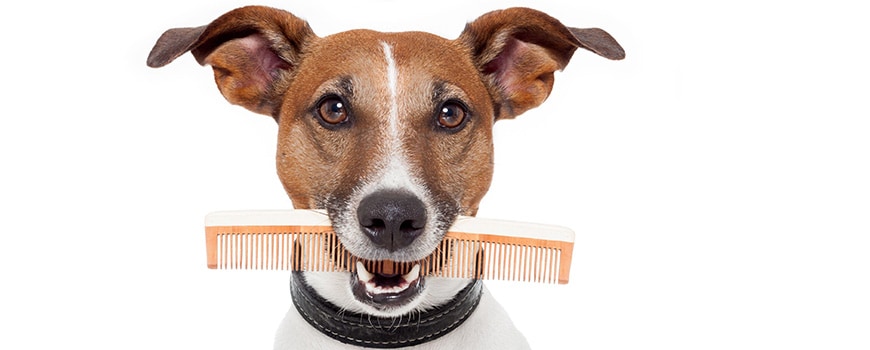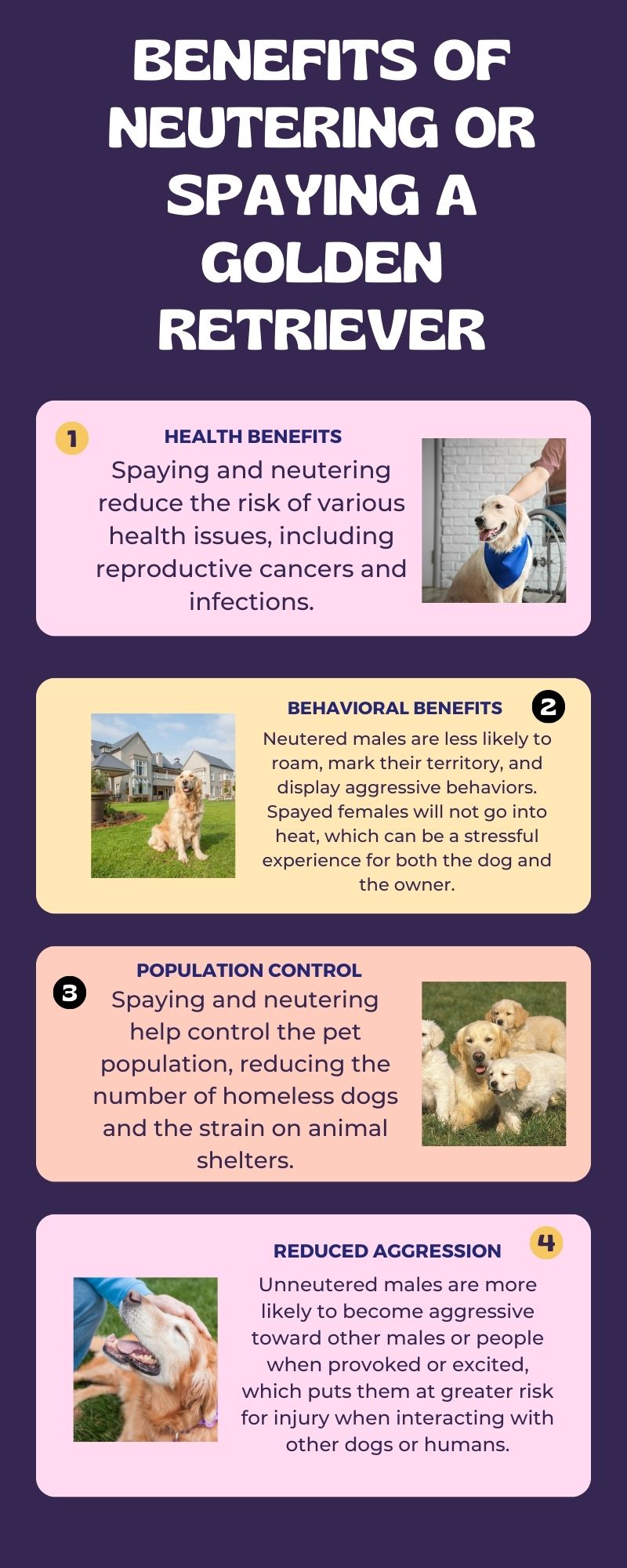Every dog owner should make the responsible choice to spay or neuter their pet. These measures benefit your dog in more ways than one, including their mental and physical health.
If you’re a Golden Retriever owner, one question that often arises is, “When to neuter or spay your furry friend?”
Your Golden Retriever should be spayed or neutered at the right age, depending on their growth and maturity. Growth and development of a golden retriever peak between 6 and 12 months of age, while other vets advise waiting until the dog is 18 to 24 months old.
To help you decide on the right age for spaying and neutering your lovely baby, this article will go into detail on the benefits of spaying and neutering your Golden Retrievers. We will also provide you with actionable steps you can take post-surgery to ensure your dog’s long-term health and happiness.
What Is Meant By Spaying And Neutering?
We will take a look at both terms by defining them separately:
Spaying
The capacity to procreate can be permanently removed from a female dog by performing surgery to remove her reproductive organs, which include the ovaries and the uterus.
Neutering
The removal of a male dog’s testicles by surgical procedures makes the animal sterile.
The Ideal Age For Neutering Or Spaying A Golden Retriever
Spaying or neutering your Golden Retriever should be done at the appropriate age, which may be determined by consulting with your veterinarian. Optimal growth and development can occur between the ages of 6 and 12 months, however, other veterinarians may recommend waiting until the dog is fully matured, about 18 to 24 months.
New evidence reveals that delaying repairing surgeries in at least certain dog breeds may be beneficial to their health (1)
Keep your Golden Retriever’s well-being and future development in mind when you make the call, since every dog is different. The veterinarian will take into account your pet’s age, size, general health, and breed when making recommendations.
The logical conclusion is to put off the procedure until after six months for a male and a year for a female.
Potential Health Risks Associated With Early Or Delayed Neutering/Spaying
There are dangers linked with both early and delayed neutering or spaying of a Golden Retriever that should be taken into account. While the likelihood of these adverse events is minimal, knowing about them before consulting with your veterinarian can help you make a well-informed choice.
Risks Of An Early Spaying Or Neutering
Before being adopted, some shelters and rescue groups will neuter or spay a Golden Retriever when they are very young, usually between six and eight weeks. It’s vital to be aware of the possible hazards of early-age neutering/spaying, despite the benefits (such as avoiding undesired litters and addressing population control):
- Orthopedic Conditions
In bigger dog breeds like Golden Retrievers, early neutering or spaying may modestly raise the risk of some orthopedic diseases. Research has linked early neutering/spaying to an increased risk of hip dysplasia, cruciate ligament injuries, and maybe some problems with the growth plate. Your dog’s long-term musculoskeletal health may be impacted by these conditions.
- Accidental Leakage Of Urine:
Neutering female Golden Retrievers at a young age may raise their risk of urine incontinence, although only marginally (2). Involuntary urination is a symptom of urinary incontinence, which can be managed with medication or other therapies.
Risks Associated With Delayed Neutering Or Spaying:
Delaying the decision to neuter or spay a Golden Retriever, normally until after the dog has reached the age of one year, is not without its dangers.
Talking to your vet about the following potential dangers may help you make a well-informed choice:
- Problems With Sexual And Reproductive Health
Spaying female Golden Retrievers should be done as soon as possible to prevent reproductive health problems. Pyometra, an infection of the uterus, is more common in female breeds who have not been spayed and can be fatal if left untreated. Delaying spaying also raises the possibility of cancerous mammary tumors. The danger of these diseases is drastically reduced if spaying is performed before the first heat cycle.
- Prostate Issues And Testicular Cancer
Testicular cancer in male Golden Retrievers is aggressive and can spread to other regions of the body if neutering is delayed. In addition, infections and benign prostatic hyperplasia (enlarged prostate) are more common in intact male breeds (3).
Benefits Of Neutering Or Spaying A Golden Retriever
Neutering and spaying have many benefits for both the dog and the owner, including:
Health Benefits
Spaying and neutering reduce the risk of various health issues, including reproductive cancers and infections.
Behavioral Benefits
Neutered males are less likely to roam, mark their territory, and display aggressive behaviors. Spayed females will not go into heat, which can be a stressful experience for both the dog and the owner.
Population Control
Spaying and neutering help control the pet population, reducing the number of homeless dogs and the strain on animal shelters.
Reduced Aggression
Unneutered males are more likely to become aggressive toward other males or people when provoked or excited, which puts them at greater risk for injury when interacting with other dogs or humans. Neutering can reduce aggressive behaviors in male Golden Retrievers, making them more amiable and easier to manage.
Best Practices For Caring For Your Golden Retriever Post-Surgery
Your Golden Retriever is a member of the family and you want to take care of them. We’ve put together some tips for caring for your Golden Retriever after surgery.
For any procedure, it’s important to do your research ahead of time. This will ensure that you know what to expect when you bring your dog in for surgery and what to look out for afterward. It also helps to know what questions to ask your veterinarian.
Here are some best practices for caring for your Golden Retriever post-surgery:
Housing
Make sure that your Golden Retriever has easy access to water and food after their procedure, as well as a warm bed where they can rest comfortably.
Follow Your Vet’s Instructions
Your veterinarian will provide specific post-operative care instructions, including pain management, wound care, and activity restrictions. Follow these guidelines closely to ensure a smooth recovery.
Monitor The Incision Site
Keep an eye on the surgical site for signs of infection or complications, such as redness, swelling, or discharge. Contact your vet immediately if you notice any issues.
Limit Activity
Restrict your dog’s activity for the first 10-14 days following surgery. Avoid running, jumping, and rough play to minimize the risk of injury or complications.
Use A Cone Or e-Collar
Prevent your dog from licking or biting the incision site by using a cone or e-collar as recommended by your veterinarian.
Schedule A Follow-Up Appointment
Schedule a post-operative check-up with your veterinarian to ensure your dog is healing properly and to address any concerns or questions.
Conclusion
Spaying and neutering are crucial decisions for Golden Retriever owners, with numerous benefits for both the dog and the owner. By understanding the ideal age for the procedure, potential health risks, and post-surgery care, you can make an informed decision that will contribute to your dog’s long-term health and happiness.
Remember to consult with your veterinarian to determine the best course of action for your specific dog, and always follow their expert guidance to ensure a successful outcome.






